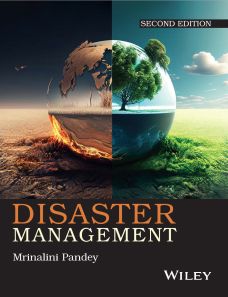Disaster Management, 2ed
ISBN: 9789357461610
272 pages
Publication Year: 2023
For more information write to us at: acadmktg@wiley.com

Description
Disasters bring with them desolation, destruction, and gloom. Knowledge about various disasters and methods to overcome them is essential for their effective management. There is a phenomenal increase in the number of disasters but still, we are far behind in tackling them effectively. The old methods of disaster management encompassing just response and recovery aspects have to be replaced with more systematic and scientifically proven methods. This book, Disaster Management, is an attempt to systematically arrange the learnings and experiences to manage disasters.
Preface
Part I Disaster Management: A Prologue
Chapter 1 Introduction to Disaster Management
1.1 Concept of Disaster
1.2 Causes and Types of Disasters
1.3 Summary of Types of Disasters
1.4 Dimensions of Natural and Anthropogenic Disasters
1.5 Aims of Disaster Management
1.6 National and International Trends in Disaster Management
1.7 Climate Change and Urban Disasters
1.8 Principles and Components of Disaster Management
1.9 Summary
1.10 Keywords and Phrases
1.11 Objective Type Questions
1.12 Questions for Review
1.13 References
1.14 Answers
Chapter 2 Disaster Management and Planning
2.1 Disaster Determinants
2.2 Nature, Scope and Management Process
2.3 Policy of Disaster Management
2.4 Types of Plans: Management by Objectives
2.5 SWOT Analysis
2.6 Hazard and Vulnerability Analysis
2.7 Identifying Crisis Situations: A Framework
2.8 Organisational Structure and Design
2.9 Authority, Delegation and Decentralisation
2.10 Roles, Skills and Competencies
2.11 Importance of Control Process in Disaster Management
2.12 Group Dynamics: Nature, Approach, and Attitudes Required to Establish Effective Autonomous Work Groups
2.13 Understanding the Importance of Team-Building in Disaster Management
2.14 Capability Assessment
2.15 National Disaster Management Authority
2.16 Summary
2.17 Keywords and Phrases
2.18 Objective Type Questions
2.19 Questions for Review
2.20 References
2.21 Answers
Part II Disaster Management Cycle: Practical Applications
Chapter 3 Disaster Mitigation
3.1 Disaster Management Cycle: An Overview
3.2 Disaster Mitigation: Meaning and Concept
3.3 Structural Mitigation
3.4 Non-Structural Mitigation
3.5 Disaster Mitigation Strategies
3.6 Importance of Information and Communication in Disaster Mitigation
3.7 Emerging Trends in Disaster Mitigation
3.8 Strengthening Capacity for Reducing Risk
3.9 Role of Team and Coordination
3.10 Sustainable Development for Disaster Mitigation
3.11 National and International Assistance in Disaster Mitigation: An Overview
3.12 Summary
3.13 Keywords and Phrases
3.14 Objective Type Questions
3.15 Questions for Review
3.16 References
3.17 Answers
Chapter 4 Disaster Preparedness
4.1 Introduction to Disaster Preparedness
4.2 The Three A’s of Disaster Preparedness
4.3 Principles of Disaster Preparedness
4.4 Steps of Disaster Preparedness
4.5 Organisational Structure for Disaster Preparedness
4.6 Essential Services Preparedness and Logistical Readiness
4.7 Contingency Planning
4.8 Importance of Building Team and Community Relations for Environmental and Emergency Managers
4.9 Training Needs Analysis and Human Resource Development Plan
4.10 Emergency Operational Plan: Contents
4.11 Summary
4.12 Keywords and Phrases
4.13 Objective Type Questions
4.14 Questions for Review
4.15 References
4.16 Answers
Chapter 5 Disaster Response
Learning Objectives
Opening Case
5.1 Aims of Response
5.2 Control Process and Measurement
5.3 Security Issues
5.4 Profile of an Effective Crisis Leader
5.5 Leading at the Time of Crisis: Competencies and Challenges
5.6 Evacuation and Migration
5.7 Administering First-Aid
5.8 Handling of Injured at Hospitals: Challenges and Issues
5.9 Mobilisation and Restoration of Essential Services
5.10 Search and Rescue Work
5.11 Modern and Traditional Methods of Response
5.12 A Model of an Ideal Command Centre
5.13 International Cooperation in Disaster Response
5.14 Summary
5.15 Key words and Phrases
5.16 Objective Type Questions
5.17 Questions for Review
5.18 References
5.19 Answers
Chapter 6 Disaster Recovery
6.1 Introduction to Medium- and Long-Term Recovery Aspects
6.2 Community Participation in Defining Objectives and Their Priorities
6.3 Identifying and Ascertaining Impact of Disaster
6.4 Participative Rehabilitation: Physical and Social Infrastructure
6.5 Social and Economic Rehabilitation: Capacity Building for Reconstruction and Rehabilitation
6.6 Recovery and Rebuilding Works
6.7 Facilitating Compensations to be Paid through Insurances and Government
6.8 Coping Strategies: Providing Counselling and Psychological Support
6.9 Summary
6.10 Keywords and Phrases
6.11 Objective Type Questions
6.12 Questions for Review
6.13 References
6.14 Answers
Part III Contemporary Issues and Challenges in Disaster Management
Chapter 7 Ascertaining Roles and Responsibilities
7.1 Global Thrust for Disaster Management
7.2 Roles and Responsibilities of Agencies
7.3 International and National Agencies
7.4 State and Local Bodies
7.5 Philanthropic Organisations
7.6 Role of Stakeholders
7.7 Impact and Role of Media
7.8 Planning Commission and Its Role
7.9 Community-Based Approach to Disaster Management
7.10 Summary
7.11 Keywords and Phrases
7.12 Objective Type Questions
7.13 Questions for Review
7.14 References
7.15 Answers
Chapter 8 Insights on Challenges in Management of Disaster
8.1 Disaster Profile of India
8.2 Management of Disasters in India
8.3 Disaster Management Policy
8.4 Education on Disasters
8.5 Public Awareness
8.6 Public Health System: Its Role in Disaster Management Prevention
8.7 Addressing Challenges Through Triage Process
8.8 Charting a Hazard Map
8.9 Effect of Culture and Disaster Management
8.10 Environmental Degradation and Disasters: Addressing Challenges
8.11 Enabling Role of Science and Technology in Management of Disasters
8.12 Role of Innovations in Managing Disasters
8.13 Media Relations and External Communications During a Disaster
8.14 Summary
8.15 Keywords and Phrases
8.16 Objective Type Questions
8.17 Questions for Review
8.18 References
8.19 Answers
Chapter 9 Behavioral Aspects of Disaster Management
9.1 Identifying Socio-Psychological Needs in Mass Emergency
9.2 Different Psychological Considerations
9.3 Training in Humanitarian Professionalism
9.4 Community and Individual Empowerment
9.5 Community Building in Developing Local Resilience to Disasters
9.6 Developing Leaders
9.7 Importance of Communication and Commitment
9.8 Negotiating the Conditions and Effects of Vulnerability and Disaster
9.9 Ethical Issues in Disaster Management
9.10 Summary
9.11 Key Words and Phrases
9.12 Objective Type Questions
9.13 Questions for Review
9.14 References
9.15 Answers
Model Question Paper 1
Model Question Paper 2
Model Question Paper 3
Model Question Paper 4
Index

